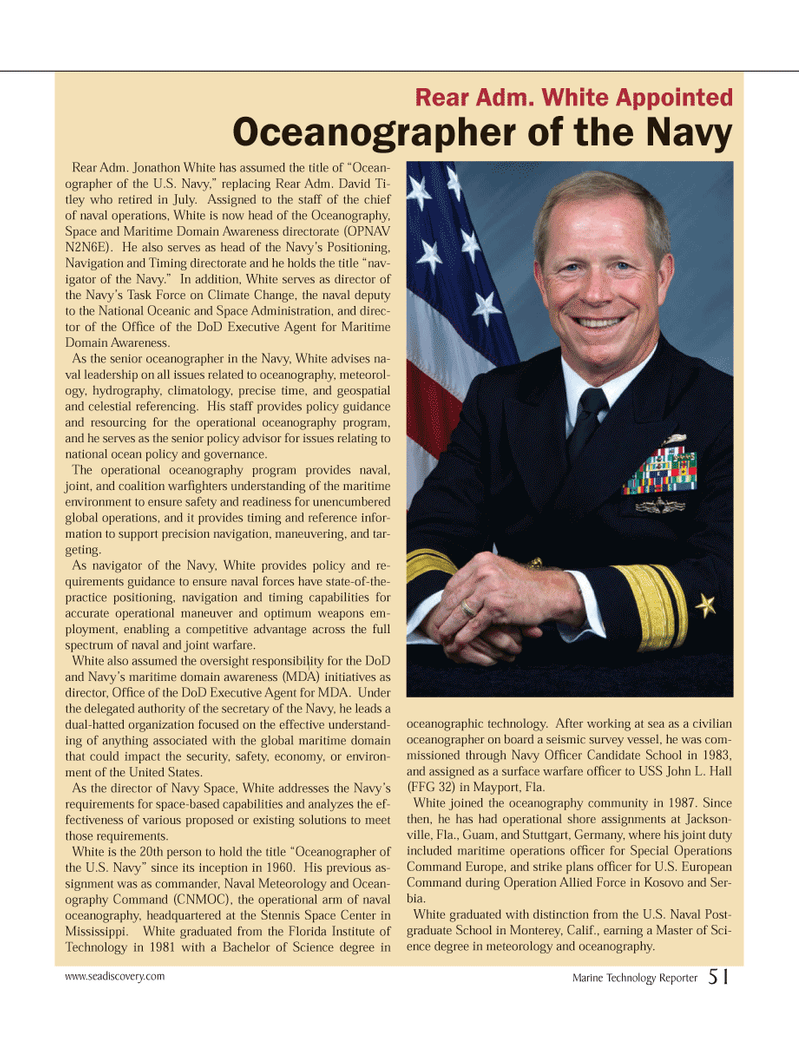
Page 51: of Marine Technology Magazine (October 2012)
Ocean Observation: Gliders, buoys & sub surface monitoring networks
Read this page in Pdf, Flash or Html5 edition of October 2012 Marine Technology Magazine
Rear Adm. Jonathon White has assumed the title of ?Ocean- ographer of the U.S. Navy,? replacing Rear Adm. David Ti- tley who retired in July. Assigned to the staff of the chief of naval operations, White is now head of the Oceanography, Space and Maritime Domain Awareness directorate (OPNAV N2N6E). He also serves as head of the Navy?s Positioning, Navigation and Timing directorate and he holds the title ?nav- igator of the Navy.? In addition, White serves as director of the Navy?s Task Force on Climate Change, the naval deputy to the National Oceanic and Space Administration, and direc- tor of the Of ce of the DoD Executive Agent for Maritime Domain Awareness. As the senior oceanographer in the Navy, White advises na- val leadership on all issues related to oceanography, meteorol- ogy, hydrography, climatology, precise time, and geospatial and celestial referencing. His staff provides policy guidance and resourcing for the operational oceanography program, and he serves as the senior policy advisor for issues relating to national ocean policy and governance. The operational oceanography program provides naval, joint, and coalition war ghters understanding of the maritime environment to ensure safety and readiness for unencumbered global operations, and it provides timing and reference infor- mation to support precision navigation, maneuvering, and tar- geting.As navigator of the Navy, White provides policy and re- quirements guidance to ensure naval forces have state-of-the- practice positioning, navigation and timing capabilities for accurate operational maneuver and optimum weapons em- ployment, enabling a competitive advantage across the full spectrum of naval and joint warfare. White also assumed the oversight responsibility for the DoD and Navy?s maritime domain awareness (MDA) initiatives as director, Of ce of the DoD Executive Agent for MDA. Under the delegated authority of the secretary of the Navy, he leads a dual-hatted organization focused on the effective understand- ing of anything associated with the global maritime domain that could impact the security, safety, economy, or environ- ment of the United States. As the director of Navy Space, White addresses the Navy?s requirements for space-based capabilities and analyzes the ef-fectiveness of various proposed or existing solutions to meet those requirements.White is the 20th person to hold the title ?Oceanographer of the U.S. Navy? since its inception in 1960. His previous as- signment was as commander, Naval Meteorology and Ocean- ography Command (CNMOC), the operational arm of naval oceanography, headquartered at the Stennis Space Center in Mississippi. White graduated from the Florida Institute of Technology in 1981 with a Bachelor of Science degree in oceanographic technology. After working at sea as a civilian oceanographer on board a seismic survey vessel, he was com- missioned through Navy Of cer Candidate School in 1983, and assigned as a surface warfare of cer to USS John L. Hall (FFG 32) in Mayport, Fla.White joined the oceanography community in 1987. Since then, he has had operational shore assignments at Jackson-ville, Fla., Guam, and Stuttgart, Germany, where his joint duty included maritime operations of cer for Special Operations Command Europe, and strike plans of cer for U.S. European Command during Operation Allied Force in Kosovo and Ser- bia.White graduated with distinction from the U.S. Naval Post- graduate School in Monterey, Calif., earning a Master of Sci- ence degree in meteorology and oceanography. Oceanographer of the Navy Rear Adm. White Appointed www.seadiscovery.com Marine Technology Reporter 51MTR #8 (50-64).indd 51MTR #8 (50-64).indd 5110/3/2012 2:42:43 PM10/3/2012 2:42:43 PM

 50
50

 52
52
